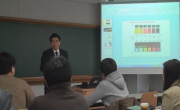Displays that are indispensable things in our lives, have developed in the direction of getting thinner, higher resolution, and richer colors. For this reason, many researchers has studied the quantum dot light emitting diode (QD-LED) which has high c...
http://chineseinput.net/에서 pinyin(병음)방식으로 중국어를 변환할 수 있습니다.
변환된 중국어를 복사하여 사용하시면 됩니다.
- 中文 을 입력하시려면 zhongwen을 입력하시고 space를누르시면됩니다.
- 北京 을 입력하시려면 beijing을 입력하시고 space를 누르시면 됩니다.
Submicron Quantum Dot Pixel Arrays Based on Electrophoretic Deposition for Light Emitting Diode = 전기영동 증착을 이용한 발광 소자용 1 μm 미만의 양자점 픽셀 배열
한글로보기https://www.riss.kr/link?id=T16718695
- 저자
-
발행사항
부산 : 부산대학교, 2023
-
학위논문사항
학위논문(박사) -- 부산대학교 , 기계공학부 정밀가공시스템전공 , 2023. 2
-
발행연도
2023
-
작성언어
영어
- 주제어
-
발행국(도시)
부산
-
형태사항
128 ; 26 cm
-
일반주기명
지도교수: 고종수
-
UCI식별코드
I804:21016-000000158083
- DOI식별코드
- 소장기관
-
0
상세조회 -
0
다운로드
부가정보
다국어 초록 (Multilingual Abstract)
Displays that are indispensable things in our lives, have developed in the direction of getting thinner, higher resolution, and richer colors. For this reason, many researchers has studied the quantum dot light emitting diode (QD-LED) which has high color purity and an ultra-thin structure that does not require a backlight. However, the technology for arraying quantum dots (QDs) for an ultra high resolution of over 2,000 ppi suitable for virtual reality (VR) devices is insufficient. Here in, I demonstrate that a new method to array the QDs in ultra high resolution which has not been reached by any technology and manufactured and evaluated a QD-LED with this QD array. For this purpose, the ligands of QDs were modified to be suitable for EPD and dispersed in water and QDs could be effectively arranged only in the pixel region through the difference in surface energy. By using electrophoretic deposition (EPD), not only a full color array of 2 μm × 6 μm sub-pixels, but also a monochromatic array of 0.5 μm width was made, thereby successfully fabricating the QD array of less than 1 μm. Here, optimal process conditions were derived using Taguchi method to uniformly deposit QDs. In addition to QDs, the zinc oxide (ZnO) layer, which is the electron injection layer (EIL) and electron transport layer (ETL), was also manufactured by EPD to avoid cross talk issues. Thus, from the EIL to the QD layer, only one photo lithography and solution process were used. The fabricated QD-LED of over 2,000 ppi achieved an external quantum efficiency of 6.31%, which showed superior performance than the toluene based conventional QD EL device, demonstrating the superiority of the QD array using EPD. In addition, it has a great meaning by showing high performance even though the resolution was kept differently from the other processes that made large pixels due to the difficulty of the process when fabricating the electroluminescence device. The proposed EPD process enables QD arrays regardless of substrate materials such as transparent substrates, opaque substrates, and flexible substrates, so, it is applicable to various industries like televisions, mobile devices, flexible displays, and transparent displays. In particular, it is expected that the era of realistic VR without screen door effect will be opened by producing of ultra high resolution displays.
목차 (Table of Contents)
- Abstract ix
- Chapter 1. Introduction
- 1.1 Quantum Dot Display 1
- 1.2 Literature Reviews of Quantum Dot Array 4
- Abstract ix
- Chapter 1. Introduction
- 1.1 Quantum Dot Display 1
- 1.2 Literature Reviews of Quantum Dot Array 4
- 1.3 Motivation of Current Work and Overview 10
- Chapter 2. Principle of Electrophoretic Deposition and Simulation
- 2.1 Principle of Electrophoretic Deposition 27
- 2.2 Analysis of Electrophoretic Deposition by Simulation 32
- Chapter 3. Ultra High Resolution Quantum Dot Arrays by Electrophoretic Deposition
- 3.1 Process of Quantum Dot Arrays by Electrophoretic Deposition 42
- 3.2 Process Optimization with Taguchi Method 44
- 3.3 Results of Ultra High Resolution Quantum Dot Array 48
- 3.4 Summary 51
- Chapter 4. Application of Quantum Dot Array : Quantum Dot Light Emitting Diode
- 4.1 Fabrication of Quantum Dot Light Emitting Diode 89
- 4.2 Characterization Methods of Quantum Dot Light Emitting Diode 93
- 4.3 Performance of Quantum Dot Light Emitting Diode 95
- 4.4 Summary 99
- Chapter 5. Conclusion 113
- Reference 117
- 국문 초록 127













